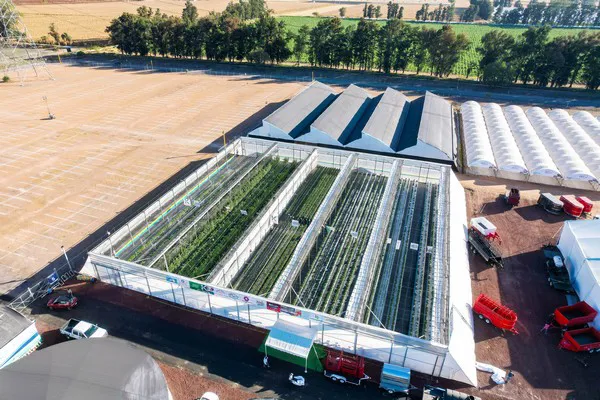The strawberry industry keeps on innovating. In Mexico, growing trials took place last year where the advantages of the natural outdoors were combined with a protected environment. “We are always trying to develop new ways for growers to increase their profitability by optimizing their growing environment,” says Richard Vollebregt, President and CEO of Cravo Equipment. Last year, the company outfitted a demonstration center in Irapuato, Mexico, to produce hydroponically grown strawberries. “We trialed three different production systems inside the retractable flat roof cooling house,” added Vollebregt.
Irapuato is at a 1,700-meter elevation and latitude 20N. The high elevation causes sun radiation to be high year-round, with occasional cloudy periods lasting only several hours during rainfall. The summer temperatures fluctuate from 20°C to 40°C with a relative humidity of 10% - 50%, while the winter temperatures fluctuate from 0°C to 31°C. Heavy rains occur from July to September.

Three different production systems
“Our focus was to evaluate three different setups in the retractable flat roof cooling house for the hydroponic gutters, which would affect plant density and the efficiency of spraying.” The different production systems included:
- Five sets of double gutters with a roadway for mechanical spraying.
- Ten single gutters.
- NGS rotating gutter system.
Impact on timing, density, and rainfall
The trials have generated key learnings in terms of timing, density, and rain. As for timing, the cooling roof allows for young plants to be transplanted during the heat in July to target the high price during the October through December window. Another benefit is that the first harvests can occur in October instead of January, provided nighttime temperatures are low enough to induce flowering. Additionally, the cooling roof helps extend the first-quality harvest into May or June.
In a tunnel, on average, 55,000 plants are grown per hectare, whereas density in a retractable roof house is 83,333 and up to 166,000 plants per hectare. The five rows of double gutters created a density of 83,333 plants per hectare and allow for mechanical spraying. The ten rows of single gutters also created a density of 83,333 plants/hectare but require manual spraying with a backpack. The NGS rotating gutter system creates the highest plant density of 166,000 plants per hectare, but also requires manual spraying with a backpack. “Higher densities do not appear to negatively affect yield per plant as retracting the roof dramatically increases light levels and rapidly lowers humidity levels,” commented Vollebregt.
“In terms of rainfall, there was no major negative impact growing in the retractable roof house as rain passes through the roof covering,” said Vollebregt. Heavy rainfall typically occurs in summer when the plants are growing vegetatively, and the plastic grow bags limit the amount of water that reaches the substrate. “The ability to retract the roof after rain allows plants to dry off rapidly.”
In this video, different hydroponic strawberry plant densities are being compared.
 For more information:
For more information:
Richard Vollebregt
Cravo Equipment Ltd
Tel.: +(1) 519 759 8226 x 215
[email protected]
www.cravo.com
